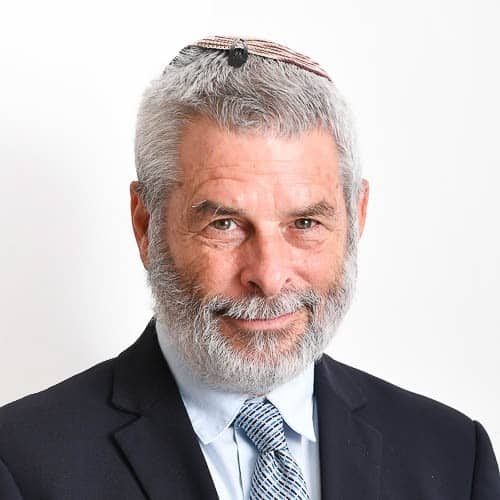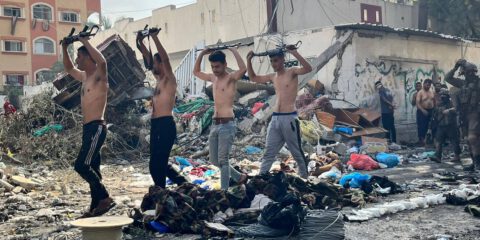Given the very small dimensions of the al-Ahli Arab Hospital, Hamas’ claims of around 500 deaths and a similar number of wounded cannot possibly be true. Such fake news fits squarely with overall casualty figures provided by the Hamas-dominated Ministry of Health during the conflict.
Hamas claimed on October 17 that an Israeli air strike on the al-Ahli Arab Hospital in Gaza City led to the death of at least five hundred people (later revised down to 471) with hundreds more wounded. Hamas’ international mouthpiece, Al Jazeera, circulated this version of events broadly on both its Arabic and English channels, and the Muslim world instantly adopted these figures as an established fact.
However, the question of who had struck the hospital almost immediately became the focal point of contention. According to Hamas and Al Jazeera, it was an Israeli missile aimed at the hospital. Israel responded to the accusation by providing visual evidence that what hit the hospital was not an Israeli missile but rather a failed rocket launch by Islamic Jihad from a launching site located in a cemetery that borders within fifty meters of the hospital. Israel also risked compromising its intelligence surveillance by publicizing an intercepted conversation between two Hamas terrorists in which one of them revealed to the other that it was indeed a failed rocket launch by Islamic Jihad that hit the hospital.
Overlooked in the ferocious debate about who hit the hospital was the plausibility of the claim that so many were killed and wounded in the attack. Looking at the physical and spatial characteristics of this small hospital, these figures look vastly exaggerated if not an outright fabrication.
The total space of the hospital (buildings and gardens) equals approximately 1,650 square meters or just over a third of an acre. The hospital consists of two small buildings (more like large homes), housing eighty beds and a large very modern glass and steel building that consists of outpatient clinics specializing in a broad range of medical and psychological departments. Together, they cover 650 square meters. The two gardens, one in the west of the small compound, and the other in the north, cover some 900 square meters. A further 100 square meters consists of shrubbery and a very small garden at the entrance to the compound.
The Anglican prelate in Jerusalem, whose diocese runs the hospital with funding from the Southern Baptist Conference, stated in an interview with the chancellor of Virginia Theological Seminary four days before the attack that the hospital employs seventy full-time and sixty part-time administrative, medical and service personnel. Since the attack took place at 7 p.m., one can safely assume that some of the administrative staff were no longer there, and thus, given that the medical staff would be working shifts, it is highly unlikely that the number of patients and staff in the building was any higher than 120-150. Regarding the outpatient building, one can safely assume that by 7 p.m. there was little activity in that building.
Hamas claimed that since the start of the war, the hospital had become a sanctuary for refugees from Israeli aerial strikes. Presumably, they were located in the two gardens covering nine hundred square meters. Even if people in knapsacks were to take refuge there in orderly lines one after the other and one beside the other, the garden could at most contain 200 to 250 people and this would not include space for basic facilities such as water, portable bathrooms and even an improvised dining space. This means that at most, there could have been 300 to 350 people in the hospital and its gardens at the time of the attack, roughly a third of the minimum number of dead and wounded claimed by Hamas and so easily accepted by Al Jazeera and the Arab states that were quick to condemn Israel and hold it responsible for the explosion. This would also mean that the rocket had either killed or maimed all those in the hospital and its grounds – an unlikely occurrence given that the explosion did not physically destroy the compound in its entirety.
The Anglican prelate, a Palestinian, who was very guarded and careful in the interview, due to the complexity of his mandate and the fact that according to him only 1,000 Christians remain in Gaza, one-tenth the number thirty years ago, spoke of those taking refuge in the hospital but he did not mention that there were hundreds in the hospital compound.
It is also striking that at least one hospital, the European Hospital in Khan Yunis, located only twenty-two kilometers from al-Ahli Hospital, no special activity was recorded after the incident. The entrance of the hospital has been filmed constantly by HD cameras since almost the beginning of the conflict. According to the Hamas-dominated Ministry of Health and the head of the intensive care unit of al-Shifa Hospital, Gaza’s largest, Gaza hospitals were running out of surgery rooms to cope with the wounded even at the beginning of the campaign. The figure of hundreds wounded in one attack would have certainly necessitated distributing the wounded among all of Gaza’s 13 hospitals. After all, even Gaza’s largest hospital, al-Shifa, has only ten operating rooms.
Perhaps the best evidence that Hamas is circulating fake news, both regarding the hospital explosion and in general, lies in the overall casualty figures cited by the Hamas-run Gazan Ministry of Health. According to the Ministry, 3,500 Gazans were killed in the first 12 days of fighting. This would mean approximately three hundred deaths a day – 15 times more than the average number of daily deaths in Gaza, according to data provided by the Palestinian Central Bureau of Statistics for 2021. This would mean hundreds of bodies stacked outside Gaza’s morgues and mass burial sites – images of which have yet to be provided – or fabricated – by Hamas.
In siding with Hamas, many are clearly not bothered by the facts. Yet, rational analysis of the data could convince reasonable level-headed thinking people, who hopefully represent the majority of the population of advanced democratic states, and especially their leaders and decision-makers.
JISS Policy Papers are published through the generosity of the Greg Rosshandler Family.
Photo: IMAGO / APAimages








 - בניית אתרים
- בניית אתרים